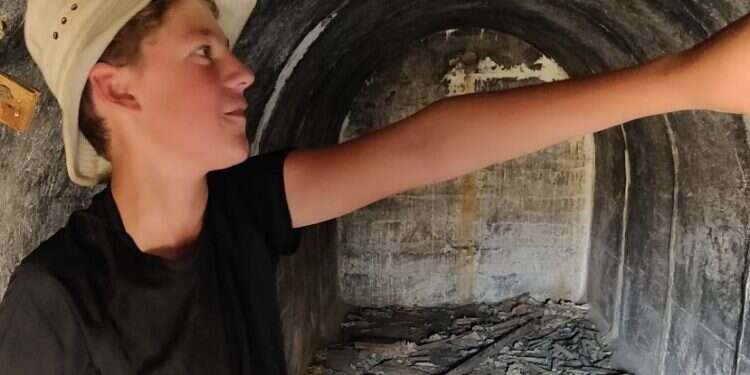For most people, the Golan Heights is wonderful for hiking, camping, dipping in chilly springs, and for resting and relaxing at the many bed and breakfasts in the area. For 13-year-old Omer Skolnik, however, the Golan Heights is fertile ground for his favorite hobby – finding historical artifacts, which is exactly what he did this week in an old Syrian army bunker.
Follow Israel Hayom on Facebook and Twitter
"For as long as I remember myself, I've had this amazing hobby of collecting artifacts," he said. "In recent years, it's developed in the direction of collecting military artifacts."
At the age of 10, he received a metal detector as a gift, and ever since he has been exploring new places, mostly historic battlefields, in search of items that can possibly shed a little light on history.
Skolnik lives in Nes Ziona and will soon enter eighth grade. One of his favorite sites to explore is an old First World War-era battlefield that saw forces from New Zealand, which fought under the Egyptian army, battle soldiers of the Ottoman Empire.
"I live next to a battlefield, and sometimes I go there with my dad or friends to look for interesting artifacts. Up until today, I've found buttons from British military uniforms and mainly old ammunition. Whatever I find I preserve and post online, and along the way, I reveal the history and learn about it myself. Even when we fly abroad, I prepare a map in advance and mark all the places we can go and look for interesting items," he said.

Last week, Skolnik and his family vacationed in the northern Golan Heights, and this time, too, he prepared a list of the places he planned to explore. "During preparations for the trip, I found a spot near the IDF Armored Corps' Revaya base in the area of Trump Heights, which was described as a Syrian bunker. We hiked in the area and eventually started exploring the bunker. At first, we didn't find it, but that's common because sometimes the openings are small and hidden," Skolnik said.
"Inside [the bunker] there was a lot of stuff, actual time capsules. We found the remnants of a hat, pieces of uniform with bloodstains, razor blades, bottles and numerous documents, one of which was dated to 1973," he continued.
Skolnik kept the documents and began the task of translating them with the help of people online and Arabic-speaking relatives.
"Based on the translation, we understood [one of the documents] was apparently written by a Syrian doctor, which contained a long list of medicines he asked the Syrian army to supply to the bunker," said Skolnik. In his estimation, the bunker was likely used by the Syrian army to concentrate and treat wounded Syrian troops.
"Exploring and researching places are two things that interest and excite me," Skolnik added. "I read and am interested in history, and I have a huge library in my bedroom with more than 200 history books. It's hard turning a hobby into a profession, but I want to be a historian. I hope I succeed."
Subscribe to Israel Hayom's daily newsletter and never miss our top stories!




